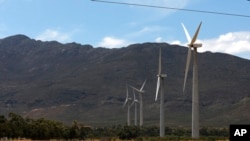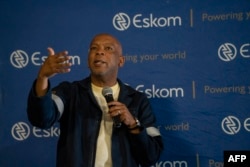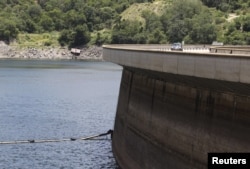"Chinese overseas renewable energy investments aim to deliver China's international climate commitments of accelerating the energy transition away from fossil fuels in Africa, China's largest trading partner," Lei Bian, a policy fellow at the The London School of Economics and Political Science, told VOA.
Making good on its green energy priority, China is the world's biggest producer of solar and wind power.
"China is clearly showing some leadership here, and they should be commended for that," Tony Tiyou, CEO of clean energy company Renewables in Africa, told VOA.
But, analysts noted, Chinese companies also benefit financially from Africa's need for such projects.
African countries contribute the least to global warming, and only about half of the continent's population has access to electricity. Many countries also have huge power deficits.
South Africa, for example, is experiencing a power crisis due to aging coal power stations and an overstretched grid, and it experiences daily rolling blackouts that are crippling the economy.
The country already has several Chinese-backed green energy projects, including the Northern Cape's De Aar wind farm, which is managed by a subsidiary of China Energy Investment Corporation.
One of the first actions by new Minister of Electricity Kgosientsho Ramokgopa was to meet last month with Chinese Ambassador Chen Xiaodong to discuss how China might help.
The Chinese Embassy in Washington referred VOA to a statement about the meeting that said the men had discussed "the provision of emergency power equipment, dispatch of technical experts, technical consultation and personnel training and other support to South Africa."
According to the statement, Ramokgopa told the Chinese ambassador that "South Africa looks forward to learning from China's experience in power development, strengthening cooperation in the power field between the two countries, and helping South Africa to get rid of the power crisis as soon as possible."
Many of the latest green energy projects China has announced in Africa are relatively small investments, analysts noted, compared with the large Belt and Road infrastructure initiatives (BRI) of the past, such as ports and railways.
This is in keeping with Beijing's shift to what leader Xi Jinping described as "small is beautiful" projects, which in part focus on China's so-called Green Silk Road.
For example, in April, Namibia's power utility NamPower and a joint Namibian-Chinese venture signed a deal to develop a 50-megawatt wind power plant in the town of Luderitz for about $100 million, according to a statement sent to VOA by NamPower.
"The Namibia project … makes a lot of sense in that scale. One hundred million is roughly in this kind of 'small is beautiful' range that the Chinese are interested in at the moment. [As] part of that pivot they've also stipulated they're particularly interested in working on projects relating to green energy," said Cobus van Staden, the managing editor of The China Global South Project.
"These are relatively small [but green] projects compared to mega hydro and coal power stations or railway projects in the previous era of BRI," Wei Shen, a political economist at Britain's Institute of Development Studies, told VOA.
One not-so-small project that has yet to be signed off on is a 1,000-megawatt floating solar farm on Zimbabwe's Kariba Dam. China Energy Engineering Corp. has proposed the $1 billion idea to Zimbabwean authorities, saying it will install 1.8 million photovoltaic panels over 146 modular floating units if the project goes ahead.
Zimbabwe has very large lithium reserves and is obliging companies that extract it to also refine it in Zimbabwe.
"So this is, of course, very energy intensive, and the companies that are doing that refining and extracting are Chinese, so there is potential there for collaboration between Chinese companies to provide the kind of energy solutions" lithium mining needs, Van Staden said.
Zimbabwean officials referred questions about the project to the Zimbabwe Electricity Supply Authority, which did not respond to VOA.
Beijing's focus on green energy comes after it faced criticism for its previous projects in Africa. Environmentalists have accused Chinese companies of polluting the environment and damaging wildlife habitats with their mining operations and infrastructure projects.
While Xi has been praised by some analysts for his 2021 pledge to not build any more coal plants abroad, van Staden noted that Xi is still working hard on securing oil and coal flows into China itself to make sure the world's second-biggest economy is energy secure.
"While the Chinese on the one hand have the world's biggest solar capacity and solar production and it installs more renewables than any other country in the world, it's also installing more nonrenewable conventional energy capacity than anywhere in the world," he said.
China has been investing in exploration and production of oil and gas in Africa. Reports say more than 25% of China's imported oil and gas come from the continent, making Africa the second-largest regional source behind the Middle East.
The China National Offshore Oil Corporation and France's TotalEnergies are the major investors in a crude oil pipeline project in East Africa, despite concerns about displacing residents and damage to the environment. Supporters of the project point to Africa's need for electricity.
"However, the majority of projects that are under planning are low-carbon energy sources, including 11 GW of hydropower and 5 GW of solar and wind power," a 2022 report by the Boston University Global Development Policy Center stated.









